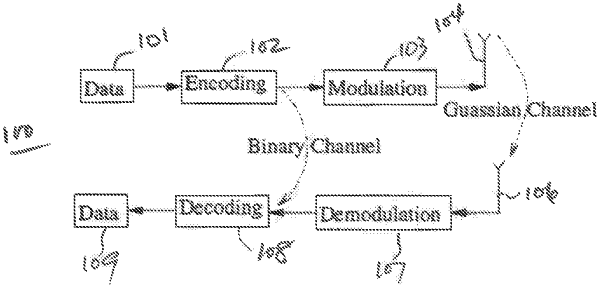| CPC H03M 13/258 (2013.01) [H03M 13/098 (2013.01); H03M 13/2963 (2013.01); H03M 13/617 (2013.01)] | 17 Claims |

|
1. A method for decoding a message in an analog signal received at a receiver, the message being encoded in Turbo Codes and modulated for transmission as a plurality of analog values in the analog signal, the message being constructed according to an error detection scheme to allow determining from a Turbo Codes-decoded result whether or not the message has been successfully decoded under the error detection scheme, the method comprising:
(i) demodulating the analog signal to recover the Turbo Codes-encoded message;
(ii) iteratively decoding the Turbo Codes-encoded message for a predetermined number of iterations to obtain a current result, wherein the iterative decoding is performed in conjunction with evaluating a probability that the current result corresponds to a correctly received message, the probability relating to the deviation of the analog values in the analog signal received from their corresponding values at transmission, the probability being in substance:
 where (a) L is a length in number of bits of the Turbo Codes, (b) Xi and Yi are one of analog values at transmission and its corresponding analog value in the analog signal received, respectively, and (c) Xi is an analog value representing either a mean or a complement of Xi;
(iii) determining from the current result whether or not the message has been successfully decoded under the error detection scheme; and
(iv) returning to step (ii) for further iterative decoding of the Turbo Codes-encoded message when the message is determined not to have been successfully decoded under the error detection scheme.
|